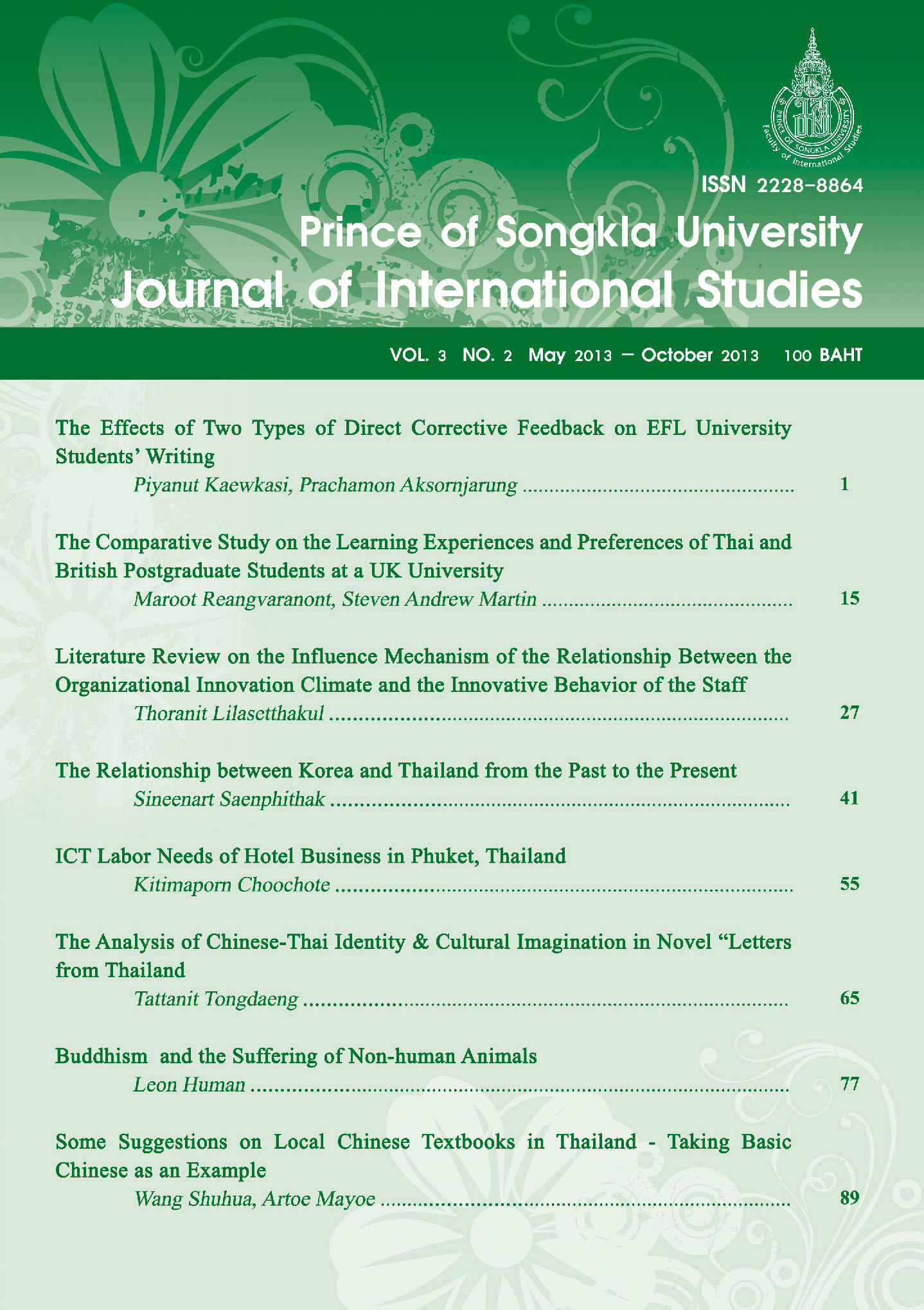The Effects of Two Types of Direct Corrective Feedback on EFL University Students' Writing
Main Article Content
Abstract
The present study investigated the effects of two types of direct corrective feedback (DCF) on writing by a group of Thai EFL learners. Twenty-five university students majoring in Languages, Communication, and Business at Prince of Songkla University, Surat Thani Campus participated in the pre, post- test designed investigation. The subjects were given a pre-test prior to attending a 13-week course on Paragraph Writing during which they were assigned to write a weekly narrative paragraph. Upon finishing each task, twelve of them received DCF with written meta-linguistic explanation (WME) and the rest received the DCF with oral meta-linguistic explanation (OME). A post- test was administered after the last session of the treatment. Scores of the pre and post tests were statistically analyzed to identify the percentage of correct usage of the two targeted grammatical features: regular past tense -ed, and fragment. Then the percentages of accurate scores between groups were compared. The results showed that the DCF with WME was as effective as the DCF with OME in reducing the errors of the two targeted linguistic forms.
Article Details
Statements and opinions expressed in articles herein are those of the authors and do not necessarily reflect the position of the editors or publisher.
Article, information, text, image, etc. which are published in Journal of International Studies, belong to Journal of International Studies. If anybody or any organization would like to use part or whole of them, they must receive written permission from Journal of International Studies before usage.
References
Bitchener, J. (2008). Evidence in support of written corrective feedback. Journal of Second Language Writing. 17(2), 102-118.
Bitchener, J. & Knoch, U. (2008). The value of written corrective feedback for migrant and international students. Language Teaching Research Journal, 12 (3), 409-431.
Bitchener, J., & Knoch, Ute (2010). Raising the linguistic accuracy level of advanced L2 writers with written corrective feedback. Journal of Second Language Writing, 19, 207-217.
DeKeyser, R. M., (2009). Practice in a second language: perspective from applied linguistics and cognitive psychology. Cambridge: Cambridge University Press.
Doughty, C. & Williams, J. (1998). Focus on form in classroom second language acquisition. New York: Cambridge University Press.
Ellis, R., Sheen, Y., Murakami, M., &Takashima, H. (2008). The effects of focused and unfocused written corrective feedback in an English as a foreign language context. System, 36, 353-371.
Ferris, D. R., (1999). The case for grammar correction in L2 Writing classes. A response to Truscott (1996). Journal of Second Language Writing, 8, 1-10.
Ferris, D. R., (2002). Second language writing research and written corrective feedback in SLA: Intersections and practical applications (2010). Studies in Second Language Acquisition, 32, 181-201.
Heyer, S., (1989). Picture series for beginning communication. New Jersey: Prentice-Hall.
Hyland, F., (2003). Focusing on form: students' engagement with teacher's feedback, System, 31, 217-230.
Kepner, C. G. (1991). An experiment in the relationship of types of written feedback to the development of second- language writing skills. Modern Language Journal, 75, 305- 313.
Krashen, S.D. (1985). The input hypothesis: Issues and implications. Harlow: Longman.
Semke, H. (1984). The effect of the red pen, Language Annals, 17, 195-202.
Schmidt, R. (1993). Awareness and second language acquisition. Annual review of applied linguistics, 1992, 13, 206-226.
Sheppard, K. (1992). two feedback types: Do they make a difference? RELC Journal, 23, 103-110.
Sheen, Y. (2007). Differential effect of focused and unfocused written correction on the accurate use of grammatical forms by adult ESL learners, System, 37, 556-569.
Sheen, Y. Wright, D. Moldawa, A. (2009). Differential effects of focused and unfocused written correction on the accurate use of grammatical forms by adults ESL learners. System, 37, 556-569.
Sheen, Y. (2010a). Differential effect of focused and unfocused written correction on the accurate use of grammatical forms by adult ESL learners, System, 37, 556-569.
Sheen, Y. (2010b). Differential effect of oral and written corrective feedback in the ESL classroom. Studies in Second Language Acquisition, 32, 203-234.
Truscott, J. 1996. The case against grammar correction in L2 writing classes. Language Learning, 46, 327-369.
Truscott, J. 1999. The case for "the case against grammar correction in L2 writing classes": A Response to Ferris, Journal of Second Language Writing, 8, 111-122.


